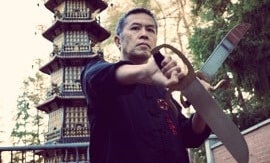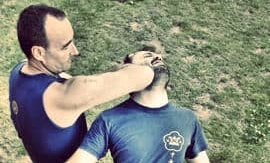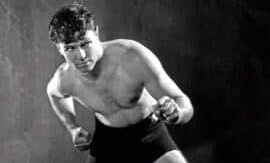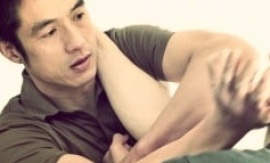
IT WAS VERY INSPIRATIONAL TO SIT DOWN AND TALK TO SIFU DONALD MAK AT HIS SCHOOL IN PRINCE EDWARD, JUST BEHIND THE VING TSUN ATHLETIC ASSOCIATION IN HONG KONG. HE IS A DOWN-TO-EARTH GENTLEMAN AND EVEN THOUGH HE ONLY TEACHES WING CHUN PART-TIME, HE HAS MANAGED TO ESTABLISH AN INTERNATIONAL ASSOCIATION WITH NEARLY 100 SCHOOLS IN 15 DIFFERENT COUNTRIES.
Sifu Mak started learning Wing Chun in 1979 from Master Chow Tze Chuen, a direct student of the late Grandmaster Ip Man. In 1987, he became an instructor in Master Chow’s school, and in 1993, with his teacher’s encouragement and blessing, he set up his own school.
During our meeting, Sifu Mak impressed me with his way of approaching Wing Chun, giving me an insight into the philosophical aspect of the system, seeing the three forms not just as physical training, but as a way of “seeking a bridge” to reach a higher level of consciousness.
As in the system that follows a certain sequence for the forms, the same happens on the path to reaching a higher self, mixing the three Chinese treasures as the fundamental teaching behind the style: Confucianism, Taoism and Buddhism. The first, as the discipline required for serious, systematic training; the second, for the concept of effortless power and yin/yang movements; and the third, as a way of clearing your mind and being open to each new teaching that the system itself always gives to you.
In your opinion, what are the most important attributes to be developed through Wing Chun training?
I feel there are two aspects: the “Practical Aspect” to develop reflexes and sensitivity, relaxation, Chung Seen and Jee Ng Seen concept (centreline and turning centreline), simultaneous defence and attack, footwork and stances. Then there’s the “Philosophical Aspect” for creating a positive mindset, Yin/Yang concept, the Confucian Doctrine of Meridians of not losing the centre, and a multi-faceted thinking approach to everyday problems.
What would you consider to be the core essentials of Wing Chun?
For me, the core concept is the centreline, the moving centreline (when we turn), static elbows and relaxation of the body.
What’s your view on whether structure is needed?
A maxim goes: “Ying Siu Bo Fa, Ying Fu Sung Yung”, meaning structure neutralises, footwork dissolves, the opponents can be handled with less effort spent. This maxim points out the importance of having good body structure and footwork.
What do you see as the meaning behind the “three empty hands” forms of Wing Chun?
Wing Chun is more than a fighting system. For me, the forms hide a philosophical meaning. With Siu Nim Tau (meaning “Little Idea”) we start developing a determination to change our actual status. With Chum Kiu (meaning “Seeking the Bridge”) we seek the bridge to reach enlightenment or a higher knowledge. Biu Ji, which is a name that originates from a Buddhist book, where a disciple points the finger to the moon, as to say that we are at a higher level of consciousness now, but we have to keep looking forward since the path, as the training, is long and difficult.
Is there any logical sequence to the order of these three forms?
Yes, there is an exact sequence in the forms, following the development of the body skills of the student during his training journey. In Siu Nim Tau we develop the Jaam Jong (Standing Still) training the basic hands’ skills. In Chum Kiu, we start moving around and the basic footwork. In Biu Ji, we start developing circular movements. So it’s a very logical sequence.
Please explain the meaning of Chi Sau and what the emphasis should be while practising it?
Chi Sau is an exercise unique to Wing Chun and is designed to bridge the empty hand forms with real combat situations. Chi Sau training is divided into three stages: Daan Chi Sau (Single-Hand Chi Sau), Sheung Chi Sau (Double-Hand Chi Sau) sometimes called Poon Sau or Luk Sau (Rolling-Hands Exercise) and Gwoh Sau (Free-Attack Chi Sau Exercise). Chi Sau is not to be confused with fighting; it develops sensitivity (the ability to assess an encounter without thinking) causing you to react instinctively with the skill to sense your opponent’s vulnerabilities while assessing your own weaknesses. The sense of touch is your fastest reflex, so if you react on that initiative you will respond faster to an attack while increasing your chances of gaining an advantage over your opponent.
What’s your opinion on the differences between the Mainland China versions of Wing Chun and the Hong Kong version?
People are different so there will be different interpretations. It is not a matter of Mainland China versions or Hong Kong version. The differences just depend on people’s different interpretations. It’s more important to understand what the differences are and the philosophy behind the differences.
How worried are you that Wing Chun is being gradually watered down?
I don’t think it has been watered down. As I just said, I think people have different interpretations and change the system to suit their own skills and physical attitude, but sometimes they don’t consider that what works for them might not work for their students. I think Wing Chun was designed to be for everyone, so I try to pass it on as close as possible to my Sifu’s interpretation, telling my student what I would do differently but teaching them the original form.
Do you feel that there’s a big difference between the students and training methods in Hong Kong and elsewhere?
I’ve noticed that students in Europe use a more systematic way of training and are also more dedicated and hardworking than students in Hong Kong. The Chinese students have easier access but might not appreciate it enough, while in Europe it can be more difficult to find a good Sifu and when they do, they are more dedicated and practise harder.
What has the Wing Chun training taught you in life?
Positive thinking, the concept of Yin/Yang and a multi-faceted thinking approach to everyday problems.
How would you like to see Wing Chun develop in the modern world?
I’d like to see Wing Chun maintain its quality and its traditional aspects.



















